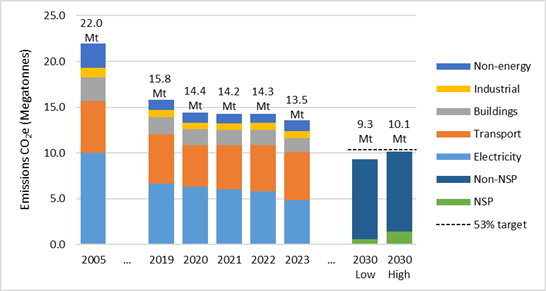Nova Scotia's seldom discussed emissions target
Larry Hughes
AllNovaScotia.com
23 April 2025
After years of hearing little else about climate change other than arguments over the consumer carbon tax, you'd be forgiven for forgetting that Nova Scotia has an emissions target for 2030.
But we do.
By the end of 2030, the province's greenhouse gas emissions are to be 53% below what they were in 2005.
Since 2030 is only a few years away, it's useful to know where we are now, where we want to go, and how we're going to get there.
Fortunately, Environment and Climate Change Canada's most recent National Inventory Report on Canada's greenhouse gas emissions for 1990 to 2023 includes emissions data for each province and territory.
The data for Nova Scotia—summarized in the next figure—shows that between 2020 (the pandemic year) and 2022, Nova Scotia's emissions showed little change, averaging about 14.3 megatonnes a year.
In 2023, provincial emissions fell to 13.5 megatonnes. This was in large part because Nova Scotia Power's emissions declined by almost a megatonne in 2023, thanks primarily to Muskrat Falls finally meeting expectations.
While Nova Scotia Power's emissions were declining, transport emissions were increasing (largely due to cars and light trucks). As a result, the transport sector, rather than Nova Scotia Power, is now the largest emitter of greenhouse gases in the province.

Nova Scotia's emissions by sector for 2005, 2019 through 2023,
and 2030 projections
(Mt = Megatonnes)
Nova Scotia's 2030 target is 10.3 megatonnes.
Meeting the target requires Nova Scotia Power to continue reducing its emissions by phasing out coal and increasing its use of renewables, as required by legislation. If this is done, Nova Scotia Power's low- and high-emissions scenarios for 2030 are projected to be between 0.55 megatonnes and 1.42 megatonnes.
This means that if sectors other than Nova Scotia Power keep their emissions unchanged from 2023, the province's total emissions will be between 9.3 megatonnes and 10.1 megatonnes in 2030, still less than the 2030 target of 10.3 megatonnes.
However, if the trend in transport emissions continues to increase, its emissions will increase by about 0.6 megatonnes by 2030. Fortunately, if emissions from buildings continue to decrease, these emissions will decrease by about 0.15 megatonnes by 2030. Taken together, the province's emissions would increase about 0.45 megatonnes.
The province could still meet its 2030 emissions target if an increase in emissions of this size occurred in Nova Scotia Power's low-emissions scenario; however, it could not if the high-emissions scenario was met or exceeded.
Emissions in the non-energy sector are primarily methane from coal mines, landfill sites, and agricultural activities. These emissions have been shown to be underreported by Environment and Climate Change Canada, meaning that the province may have more to deal with than what is listed in the National Inventory Report.
The cost-of-living crisis and the threats of annexation and higher tariffs from the United States are understandably top-of-mind for most Nova Scotians rather than how the province can meet its 2030 greenhouse gas emissions target.
At a time like this, the province—and Canada for that matter—needs leaders who understand the challenges and concerns many Canadians are facing, and the risks climate change poses to Canada and Canadians. And have the resourcefulness to address both for the betterment of all.